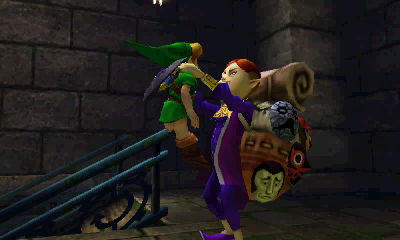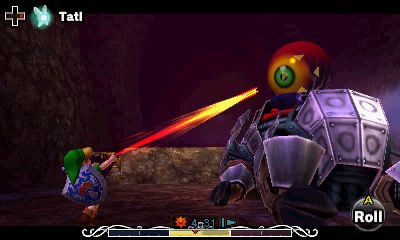

While the masks in Ocarina of Time are limited to an optional side-quest, they play a central role in Majora's Mask, which has twenty-four masks in total. Fifteen are set through a dungeon and the player has to find them all and put them back in their respective fountain to gain a new ability, such as a greater defense or an upgraded "Spin Attack". New to Majora's Mask are little fairies, which are collectibles. The player also has to find a key to unlock the boss' room. Similar to A Link to the Past and its predecessor which is now a tradition into the series, the player can obtain a map and a compass for assistance, although they are optional. These dungeons includes numerous puzzles that the player need to solve with its actual equipment and/or mechanics set in the dungeon depending on its theme. Similar to the other games, the player has to progress through a variety of dungeons. Magic power allows attacks such as magical arrows or spin attacks and the use of special items such as the Lens of Truth, which allows the player to see invisible objects and disappears fake objects. He can also latch onto objects or paralyze enemies with the Hookshot.

Link's main weapon is a sword, and other weapons and items are available-Link can block or reflect attacks with a shield, stun enemies by throwing Deku Nuts, attack from a distance with a bow and arrow, and use bombs to destroy obstacles and damage enemies. As in previous installments, Link can perform basic actions such as walking, running and limited jumping (although sometimes Link performs flips), and must use items to battle enemies and solve puzzles. It retains the concept of dungeon puzzles and ocarina songs and introduces new elements including character transformations and a three-day cycle. The gameplay of Majora's Mask expands on that of Ocarina of Time.
Legend of zelda majoras mask walk through series#
See also: Gameplay of The Legend of Zelda series

An enhanced remake for the Nintendo 3DS, titled The Legend of Zelda: Majora's Mask 3D, was released in February 2015. The game was rereleased for the GameCube in 2003 as part of The Legend of Zelda: Collector's Edition, for the Wii's Virtual Console service in 2009 and for the Wii U's Virtual Console service in 2016. While the game only sold about half as many copies as its predecessor, it generated a substantial cult following.

It received praise for the gameplay, graphics, story and has been noted for its darker tone and themes compared to the other titles in the franchise as well for its distinct art style and level design. Majora's Mask earned widespread critical acclaim from critics and is widely considered one of the best video games ever made. On the Nintendo 64, Majora's Mask-unlike Ocarina of Time-required the Expansion Pak, which provided additional memory for more refined graphics and greater flexibility in generating on-screen characters. Characteristic of the Zelda series, completion of the game involves successfully traversing through several dungeons, each of which contain a number of complex puzzles and enemies. As the player progresses through the game, Link also learns to play numerous melodies on his Ocarina, which allow him to control the flow of time or open passages to four temple dungeons. The game introduced several novel concepts, revolving around the perpetually repeating three-day cycle and the use of various masks that can transform Link into different beings. Upon reaching Termina, Link learns that the world is endangered as the moon will fall into the world in three days. It follows Link, who on a personal quest ends up in Termina, a world parallel to Hyrule. The story of Majora's Mask takes place two months after the events of Ocarina of Time. It featured enhanced graphics and several gameplay changes from its predecessor, though it reused a number of elements and character models, which the game's creators called a creative decision made necessary by time constraints. Designed by a creative team led by Eiji Aonuma, Yoshiaki Koizumi, and Shigeru Miyamoto, Majora's Mask was completed in less than two years. It was released worldwide in 2000 as the sixth main installment in The Legend of Zelda series and was the second to use 3D graphics, following 1998's The Legend of Zelda: Ocarina of Time, to which it is a direct sequel. The Legend of Zelda: Majora's Mask is an action-adventure game developed and published by Nintendo for the Nintendo 64 home console.


 0 kommentar(er)
0 kommentar(er)
